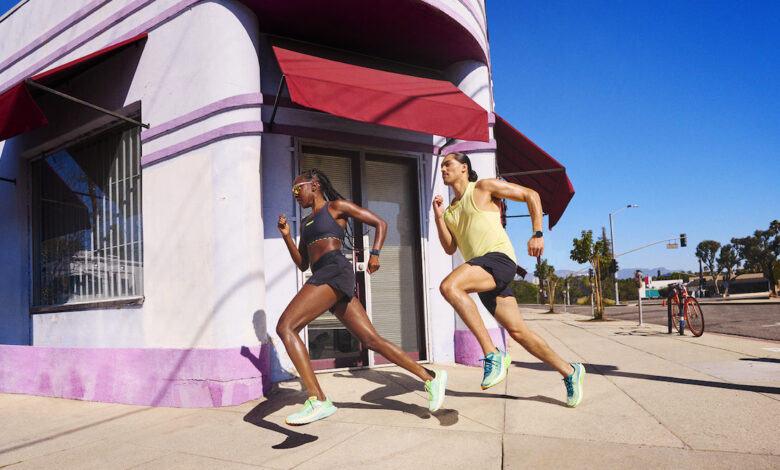Hoka’s New Podiatrist-Approved Plated Training Shoe Is So Comfortable, I Feel Like I Could Run for Miles and Miles

It’s rare that I’ve tried a running shoe and had no notes. But that’s how I felt about Hoka’s Mach 5 from my first run in them: During my easy warm-up miles, they felt soft and light, and when I picked up the pace for some intervals, I was shocked by how bouncy they were, and how easy it felt to hit some fast-for-me paces. I’ve been in love ever since, especially since they’re versatile enough for nearly any kind of run.
So when I learned Hoka was adding a plate to the fan-favorite shoe, I was intrigued, especially since I’ve also fallen in love with the emerging category of “super trainers”—or shoes with plates (usually carbon) meant for training rather than racing (like New Balance’s Fuel Cell SuperComp Trainer and Nike’s ZoomFly). In other words, you get the fun propulsion of a fast shoe, without the guilt of “wasting” your fastest, most expensive shoes or of “cheating” on all your training runs. Hokas new Mach X ($180) seems to be their answer to the super trainer, so obviously I needed to take it out for a few spins.
What’s new in the Mach X
Like with its little sister the Mach 5, I could immediately tell that the Mach X was going to be a versatile shoe. That’s because unlike most other plated training shoes that use a rigid carbon plate—which is highly propulsive but can feel somewhat aggressive, and impossible to log easy miles on—the Mach X’s pebax plate is far more subtle and flexible.
Depending on what you’re looking for in a shoe, that could be a good or bad thing. Aside from a bit of snappiness and added propulsion, I hardly noticed the plate at all, and while I liked the smooth, comfortable ride, it didn’t feel much faster than the Mach 5 to me. This could be because it’s quite a bit bigger than the Mach 5, with 1.2 ounces of additional weight, and 10mm of added height and cushion (for a total of 39mm at the heel and 34mm at the front). It’s also relatively wide, making it stable but slightly bulky when trying to push the pace. But with both added stability and cushion, the Mach X ranks above the Mach 5 for me for long runs.

One thing I missed from the Mach 5: The rubberized EVA outsole, which is one of the reasons why that shoe feels so soft despite its relative lack of cushioning. The Mach X’s rubber outsole is certainly more durable, but feels firmer when landing.
What a podiatrist has to say
I asked Mark Mendeszoon, DPM, a podiatrist who owns two running shoe stores in Ohio and Pennsylvania, what he thinks of the shoes so far, and he, too was impressed with their versatility, adding that he could see the shoe working as a daily trainer, but also for tempo runs or even races. He’s also a fan of the dual density foam—it has both the more traditional EVA foam and the softer peba foam used in Hoka’s racing super shoe, the Rocket X 2—and the plate, “which merge in the forefoot to give a very quick and responsive energy return on toe-off,” he says.
“The shoe is a little more aerodynamic than the traditional Hokas and they are quite comfortable,” he says.
But those with a wide foot or bunions should take note, he warns: The forefoot is slightly tapered, which I noticed after a few miles as my toes started to feel compressed. (Runners with wide feet may want to consider sizing up a half-size; otherwise, unlike many Hoka shoes which tend to run big, it seems to fit true-to-size, says Mendeszoon.)
His only other note for the Mach X? It could be more breathable. I’m pretty sure I agree, though I hesitate to judge breathability in the 80 degree, 90 percent humidity weather I’ve been running in.
Who the Mach X is right for
I could see myself taking the Mach X out for anything from a long run to a tempo run to possibly even speedwork. While the plate is flexible enough that the shoes could work for easy miles, I’ll probably stick with something unplated (like Hoka’s Clifton) for slow miles and save the Mach X for more uptempo runs.
Though Hoka seems to want the Mach X to be a shoe that could bridge training and racing, personally I probably won’t be racing in it—it just doesn’t quite have that running-on-little-trampolines feeling that makes me feel my fastest when wearing true super shoes, like Hoka’s Rocket X 2. That said, the Mach X is a great alternative to the super shoe for those who aren’t into carbon plates, or who want a more stable “super trainer” that can also work for slower miles.



